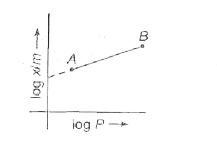What do you understand by adsorption isotherm and adsorption isobar ? Explain Freundlich adsorption isotherm for the adsorption of gases on solids.
Step-by-Step Solution:
1. Understanding Adsorption Isotherm:
- An adsorption isotherm is a graphical representation that shows the relationship between the amount of adsorbate (gas) adsorbed on a solid adsorbent and the pressure of the gas at constant temperature.
- The y-axis of the graph represents the extent of adsorption (X/M), where X is the mass of the adsorbate and M is the mass of the adsorbent. The x-axis represents the pressure (P) of the gas.
2. Components of the Adsorption Isotherm:
- The extent of adsorption (X/M) depends on the pressure of the gas.
- At low pressures, the relationship can be expressed as:
XM∝P(linear relationship)
This can be simplified to:
XM=kP
where k is a constant.
3. Behavior at High Pressure:
- At high pressures, the extent of adsorption becomes independent of pressure:
XM=k(constant)
- This indicates that the amount of gas adsorbed does not change with an increase in pressure.
4. Behavior at Intermediate Pressure:
- At intermediate pressures, the relationship between the extent of adsorption and pressure is given by:
XM∝Pn
where n is a fractional exponent that lies between 0 and 1. This indicates a non-linear relationship.
5. Freundlich Adsorption Isotherm:
- The Freundlich adsorption isotherm is an empirical relationship that describes how the extent of adsorption varies with pressure. It can be expressed as:
XM=kPn
- Here, k and n are constants that depend on the nature of the adsorbate and adsorbent. The value of n indicates the degree of adsorption.
6. Understanding Adsorption Isobar:
- An adsorption isobar is a graph that shows the relationship between the extent of adsorption and temperature at constant pressure.
- This graph helps distinguish between physical and chemical adsorption. In physical adsorption, the extent of adsorption decreases with increasing temperature, while in chemical adsorption, it may initially increase before decreasing.
- An adsorption isotherm is a graphical representation that shows the relationship between the amount of adsorbate (gas) adsorbed on a solid adsorbent and the pressure of the gas at constant temperature.
- The y-axis of the graph represents the extent of adsorption (X/M), where X is the mass of the adsorbate and M is the mass of the adsorbent. The x-axis represents the pressure (P) of the gas.
- The extent of adsorption (X/M) depends on the pressure of the gas.
- At low pressures, the relationship can be expressed as:
XM∝P(linear relationship)
This can be simplified to:
XM=kP
where k is a constant.
- At high pressures, the extent of adsorption becomes independent of pressure:
XM=k(constant)
- This indicates that the amount of gas adsorbed does not change with an increase in pressure.
- At intermediate pressures, the relationship between the extent of adsorption and pressure is given by:
XM∝Pn
where n is a fractional exponent that lies between 0 and 1. This indicates a non-linear relationship.
- The Freundlich adsorption isotherm is an empirical relationship that describes how the extent of adsorption varies with pressure. It can be expressed as:
XM=kPn
- Here, k and n are constants that depend on the nature of the adsorbate and adsorbent. The value of n indicates the degree of adsorption.
- An adsorption isobar is a graph that shows the relationship between the extent of adsorption and temperature at constant pressure.
- This graph helps distinguish between physical and chemical adsorption. In physical adsorption, the extent of adsorption decreases with increasing temperature, while in chemical adsorption, it may initially increase before decreasing.
Topper's Solved these Questions
- SURFACE CHEMISTRY BOOK - ICSECHAPTER - SURFACE CHEMISTRY EXERCISE - ISC EXAMINATION QUESTIONS
4 Videos
- SURFACE CHEMISTRY BOOK - ICSECHAPTER - SURFACE CHEMISTRY EXERCISE - EXERCISE (PART-II ( DESCRIPTIVE QUESTIONS )) ( SHORT ANSWER QUESTIONS)
81 Videos
- SPECIMEN QUESTION PAPERBOOK - ICSECHAPTER - SPECIMEN QUESTION PAPEREXERCISE - QUESTION
140 Videos
- THE SOLID STATEBOOK - ICSECHAPTER - THE SOLID STATEEXERCISE - MULTIPLE CHOICE QUESTIONS (Assertion-Reason based questions)
10 Videos
Similar Questions
Knowledge Check
Physical adsorption is:
AirreversibleBhighly specificCnot very specificDunpredictable
What is an 'adsorption isotherm ? Describe Freundlich adsorption isotherm.
View SolutionWhat is an adsorption isotherm? Describe Freundlich adsorption isotherm.
View SolutionWhat do you understand by the term adsorption, absorption and sorption ?
View SolutionIn Freundich adsorption isotherm
The slope of the AB line

View SolutionIn freundlich adsorption isotherm, the value of 1/n is
View SolutionThe equation for Freundlich adsorption isotherm is
View SolutionAbsorption and adsorption
View Solution
